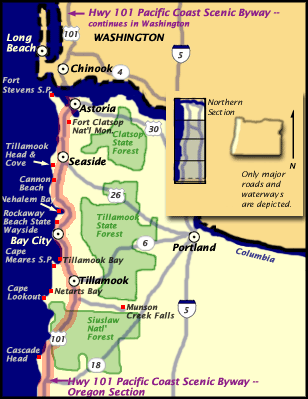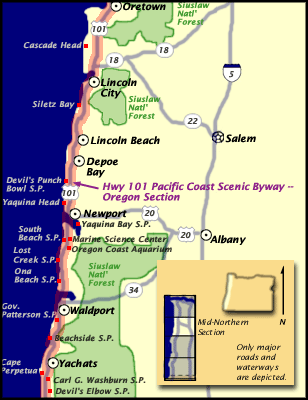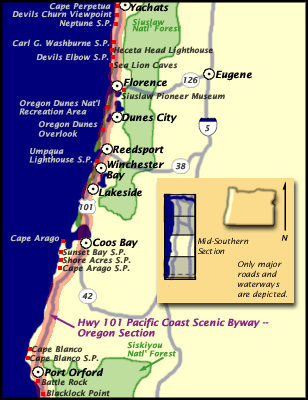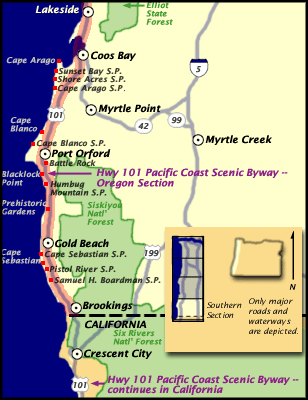|
Length: 363 miles / 580.8 km Time to Allow: Plan 10 to 12 hours to experience all this Byway has to offer. Distances and Driving Directions US 30, US 26, Oregon 6, and Oregon 18 provide access to the northern portion of the scenic Byway from the Portland metropolitan area and Portland International Airport. US 30 leads to Astoria and the Fort Clatsop National Memorial (Lewis and Clark), US 26 to Seaside, Oregon 6 to Tillamook, and Oregon 18 to Lincoln City. From the center of the state along I-5 and the cities of Salem, Albany, and Eugene, Oregon 22, 20, 34, and 126 provide access respectively to Lincoln City, Newport, Waldport, and Florence and the National Scenic Dunes Recreational Area along the central portion of the scenic Byway. The Eugene International Airport is near Oregon 126. Farther south, Oregon 38 runs from I-5 to Reedsport, and Oregon 42 connects Roseburg to Bandon by the sea. From Grants Pass along I-5, the most southern city of the scenic Byway can be accessed by following US 199 toward Crescent City, California, then north 17 miles to the Oregon border, and another 5 miles north to Brookings. Other regional Airports with public service are located in Medford,Oregon and Crescent City, California. Medford is approximately 2 hours from the southern Oregon Coast and Crescent City is 21 miles south of the Oregon Border. Oregon is also served by Amtrak rail through the Willamette Valley with stations in Eugene, Albany, Salem, and Portland. Each of these stations is approximately 1 hour from the Oregon Coast and US 101. Once you reach US Highway 101 in Astoria, you travel south on the Highway, following the coast, until you reach the California border. The California section of the Pacifc Coast Highway then begins. Description Parallel the Lewis and Clark Trail as you travel past shining beaches and hushed temperate rain forests for dozens of miles. Stop by attractive places such as the resort town of Seaside, famous for its two-mile beachfront promenade, and the busy Garibaldi fishing port on Tillamook Bay. The southern portion of the Byway changes a little, as it is dominated by rugged cliffs, farms, and sandy beaches. This segment boasts some of the most photographed areas in Oregon. Be sure to snap a shot of Siletz and Depoe Bays, the colorful Oregon skies, the beautiful dairy land, and the city of Tillamook, where a famous brand of cheese is produced. Points of Interest Aquariums and Marine Centers The Oregon Coast Aquarium ranks among the top 10 aquariums in the nation, and since its opening in 1992, it has offered an excellent collection of marine treasures. Its indoor exhibits feature marine life found in wetlands, sandy and rocky shores, and the deep waters of the Pacific Ocean. Outdoor exhibits are home to feature sea otters, seals, sea lions, and a giant Pacific octopus. The Aquarium also has one of the largest walk-through seabird aviaries in North America. The Oregon Coast Aquarium is dedicated to marine education and conservation and was home to Keiko the whale, star of the movie "Free Willy", from 1996-1998. The Mark O. Hatfield Marine Science Center was built in 1965 and is the hub of Oregon State University's coastal research. The center is dedicated to helping solve problems that affect marine life all over the world. It has recently gone through a $5 million renovation and remodeling (it was closed for more than a year and reopened in 1997.) The newly renovated Center has a public wing that focuses on the research and findings of the Center's 300+ marine scientists. Their work is presented through interactive multimedia displays based on the theme, "Searching for Patterns in a Complex World." Through these displays, visitors can explore the geology of the ocean floor, learn about coastal hazards (such as earthquakes and tsunamis,) and find out about advancements made in whale tracking and research. The center's exhibits include a "touch" tank of tidal animals and a live octopus. Astoria Throughout the years, Astoria has remained an important commercial center. The city today is known for its charming Victorian architecture, steep streets, and views of the Columbia River. A number of historic sites are located within the city, including: Fort Astoria Park, Heritage Museum, Flavel House, Columbia River Maritime Museum, Astoria Column, and the Old Firefighter Museum. |
 |
 |
|
 |
|
|
|
Pacific Coast Scenic Byway
Region:
